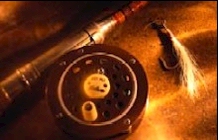Mention the Wise River
Valley to tourist or anglers and few will venture to
guess what state it resides in. Unbeknownst the
beautiful valley bestows the romance of Montana's
early history. The Wise River Valley is situated
between the Pioneer and Odell Mountain ranges in
Southwestern Montana. The river begins roughly 30
miles south of the rustic little town of Wise River.
In late spring
these large boulders provide fish a break from the
Wise River's swift current during run-off.
 |
Several mountain streams and springs from these two
ranges converge in the valley, creating one of the
fastest flowing tributaries in North America. The
cold crystal clear waters journeys north through
beautiful valleys, and plush meadows until its
convergence with Montana's famed fishery, the "Big
Hole River". The Wise River Valley is abundant with
wildlife such as elk, moose and deer and occasionally
bears and mountain lions can be seen along the
foothills.
The Wise River by no means is a large river, a more
accurate description would be creek, but it has a
certain mystic charm about it and its surroundings.
Access to the river is fairly close from the scenic
byway that runs along the river. This however does not
mean one can simply pull off to side of the road and
start casting line. Many good holding areas spotted
from the highway require lumbering through some rather
thick and deep brush.
Author with
a large Wise River Cutthroat.
 |
I dare say this may be a reason why many anglers
elect not to fish some good holding areas.
The river is host to such species as rainbows,
browns, cutthroats and brook trout. Rocky Mountain
Whitefish are also present, as well as Artic Grayling.
A large fish caught on the Wise will not turn heads in
comparison to some daddys caught on the Big Hole. On
average a fish on the Wise will tend to be about
eleven or twelve inches in length, plenty big enough
when fishing with light gear. On a few occasions fish
in the four and five pound class are caught, a
difficult task considering the Wise often requires 6x
tippets to fish the crystal clear waters. During its
30 mile trek the Wise which is seldom more broader
than thirty feet, will changes character a few times.
The Wise is one the few rivers where the waters will
tumble for hundreds of yards. Much of the river's
banks are choked with willows and some areas host deep
undercut banks. Fly-fishing anglers will find the
river requires a touch of casting finesse and quite
often it may be best using a dead drift.
While dry fly fishing
appears to be the technique most anglers prefer,
streamers and nymphs are equally as effective. Hatches
are normally in full-swing by mid June and July.
Anglers should pay special attention to large
boulders, undercuts and fallen timber as they harbor
many fish from the rivers swift current. In the fall
months baetis type flies work well in warmest part of
the day. Autumn is also when valley is at its finest
as the crisp morning air and brilliant fall colors
provide images that will not likely ever leave your
mind. It's also this time of year ruthless browns from
the Big Hole move in. These browns can be merciless on
tippets and leaders, but are ever bit worth it.
Winters in the Wise
River Valley can be quite severe. Temperatures are
often brutal, dropping well below zero. When the river
begins to thaw in spring, good fishing is not very far
off.
If you like small rivers, the Wise River and its
setting are very difficult to beat.
Tackle & Gear:
For most fishing on the Wise River an eight foot,
two or three-weight rod is a good choice. The
exception would be in fall when large browns move in
for spawning. For this a five or or six-weight system
would be the wiser choice, keeping in mind that some
of the browns can push 8 or 9 pounds. Good insulated
waders are advisable through June.


